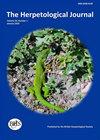Aliens in the backyard: Did the American bullfrog conquer the habitat of native frogs in the semi-deciduous Atlantic Forest?
IF 1.1
4区 生物学
Q3 ZOOLOGY
引用次数: 3
Abstract
The American bullfrog Lithobates catesbeianus has a natural distribution in North America, but was spread by human activities in different regions around the world. It is listed as the most invasive amphibian species, affecting terrestrial and aquatic ecosystems and the community of native species. In addition, the American bullfrog is extensively associated with lethal pathogens, with high correlation of the presence of this species with population declines and extinctions. Here we test if this alien species has spread through the landscape, establishing populations at new locations. We used diverse methods including georeferencing of satellite images, ethnobiological interviews and field data to evaluate the dispersion and effects of L. catesbeianus introduction on amphibian composition, species number, and density of individuals in forest fragments in an Atlantic Forest landscape. We did not find any relationship between density of individuals, number of species or composition of the native anuran assemblages in forest fragments in relation to the presence or proximity of American bullfrog introduction points. Additionally, we found that the dispersion potential of this species in the studied landscape is zero, as it was only found in those fragments where it was specifically introduced 15 years ago. The species has not established new populations in the landscape. Although exotic, L. catesbeianus thrives in lentic habitats and has no apparent effect on the structural metrics of the native anuran assemblage. Despite this alien species exhibiting a capacity to adapt and survive at the point of introduction, its potential for propagation is limited probably by the fragmented terrestrial landscape and regional stream network.后院的外星人:美洲牛蛙是否征服了大西洋半落叶森林中本土青蛙的栖息地?
美洲牛蛙(Lithobates catesbeianus)在北美有自然分布,但由于人类活动在世界不同地区传播。它被列为最具入侵性的两栖动物物种,影响陆地和水生生态系统以及本地物种群落。此外,美洲牛蛙与致命病原体广泛相关,该物种的存在与种群数量下降和灭绝高度相关。在这里,我们测试这种外来物种是否已经在景观中传播,在新的地点建立种群。采用卫星影像地理参考、民族生物学访谈和野外数据等方法,对大西洋森林景观中森林破碎片中两栖动物的分布、物种数量和个体密度进行了评价。我们没有发现美洲牛蛙种群的个体密度、种类数量或组成与美洲牛蛙引种点的存在或邻近之间存在任何关系。此外,我们发现该物种在研究景观中的扩散潜力为零,因为它只在15年前专门引入的那些片段中被发现。该物种尚未在景观中建立新的种群。虽然是外来物种,但它在原生生境中生长旺盛,对原生无尾虫群落的结构指标没有明显影响。尽管这种外来物种在引进时表现出适应和生存的能力,但其传播的潜力可能受到陆地景观和区域河流网络的限制。
本文章由计算机程序翻译,如有差异,请以英文原文为准。
求助全文
约1分钟内获得全文
求助全文
来源期刊

Herpetological Journal
生物-动物学
CiteScore
2.40
自引率
10.00%
发文量
25
审稿时长
>12 weeks
期刊介绍:
The Herpetological Journal is the Society''s prestigious quarterly scientific journal.
 求助内容:
求助内容: 应助结果提醒方式:
应助结果提醒方式:


